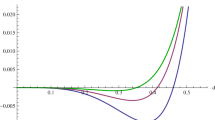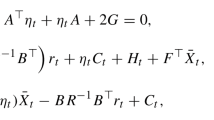Abstract
This paper considers an economy using a technology that adds to a stock of pollution. Examples that come to mind are SO2-emissions from burning coal accumulating in the soil and CO2-emissions from fossil-energy use which are retained in the atmosphere. The stock of pollutants is subject to natural decay, albeit not necessarily of the simple often assumed linear type. In addition, a clean or so-called backstop technology is available that requires costly investments but is characterized by low variable costs (e.g., solar energy or wind power). The costly investments imply a slow build-up of the capacity of the backstop. On the modelling side, this is an essential extension of most of the literature that considers the unrealistic case where a backstop is instantaneously available. The second extension the present paper makes is to consider not only the planning problem but also the competitive outcomes. One of the interesting results is that stable limit cycles may characterize the socially optimal long-run outcome as well as the competitive equilibrium. In a competitive equilibrium pollution-control policy is not necessarily optimal in the sense of corresponding with the social optimum. Although cycling can occur in a competitive equilibrium, just as in the social optimum, relaxation of the control increases the set of parameter values for which complex and unstable behavior arises.
Similar content being viewed by others
References
Brock, W., and Malliaris, A. (1989):Differential Equations, Stability and Chaos in Dynamic Economics. Amsterdam: North-Holland.
Comolli, P. (1977): “Pollution Control in a Simplified General-Equilibrium Model with Production Externalities”.Journal of Environmental Economics and Management 4: 289–304.
Dasgupta, P. (1982):Control of Resources. Oxford: Blackwell.
Dockner, E. (1985): “Local Stability Analysis in Optimal Control Problems with Two State Variables”. InOptimal Control Theory and Economic Analysis 2, edited by G. Feichtinger. Amsterdam: North-Holland.
Feichtinger, G., Novak, A., and Wirl, F. (1994): “Limit Cycles in Intertemporal Adjustment Models”.Journal of Economic Dynamics and Control 18: 353–380.
Foster, B. (1975): “Optimal Pollution Control with a Nonconstant Exponential Rate of Decay”.Journal of Environmental Economics and Management 2: 1–6.
Guckenheimer, J., and Holmes, P. (1983):Nonlinear Oscillations, Dynamical Systems, and Bifurcation of Vector Fields. New York: Springer.
Holling, C. (1973): “Resilience and Stability of Ecological Systems”.Review of Ecology and Systematics 4: 1–23.
Khibnik, A., Kuznetsov, Y., Levitin, V., and Nikolaev, E. (1992):Interactive LOCal BIFurcation Analyzer (Manual). Amsterdam: Expertise Centre for Computer Algebra in the Netherlands (CAN).
Mäler, K. G. (1999): “Nonlinear Systems in Environmental Economics”. Joseph Schumpeter Lecture, European Economic Association Annual Congress, Santiago de Compostela, Spain.
Pethig, R. (1993): “Ecological Dynamics and the Valuation of Environmental Change”. Mimeo, University of Siegen, Siegen, Germany.
Tahvonen, O., and Withagen, C. (1996): “Optimality of Irreversible Pollution Accumulation”.Journal of Economic Dynamics and Control 20: 1775–1795.
The Economist (July 24th, 1999): “Fuel Cells Meet Big Business”, pp. 63–64.
Toman, M., and Withagen, C. (1996): “Acumulative Pollution, ‘Clean Technology’ and Policy Design”.Resource and Environmental Economics 22: 367–384.
Wirl, F. (1991): “Monopolistic Resource Extraction and Limit Pricing: the Market Penetration of Competitively Produced Synfuels”.Environmental and Resource Economics 1: 157–178.
— (1996): “Pathways to Hopf Bifurcations in Dynamic, Continuous Time Optimization Models”.Journal of Optimization Theory and Applications 91: 299–320.
— (1997): “Stability and Limit Cycles in One-dimensional Dynamic Optimizations of Competitive Agents with a Market Externality”.Journal of Evolutionary Economics 7: 73–89.
Author information
Authors and Affiliations
Rights and permissions
About this article
Cite this article
Wirl, F., Withagen, C. Complexities due to sluggish expansion of backstop technologies. Zeitschr. f. Nationalökonomie 72, 153–174 (2000). https://doi.org/10.1007/BF01676981
Received:
Revised:
Published:
Issue Date:
DOI: https://doi.org/10.1007/BF01676981




